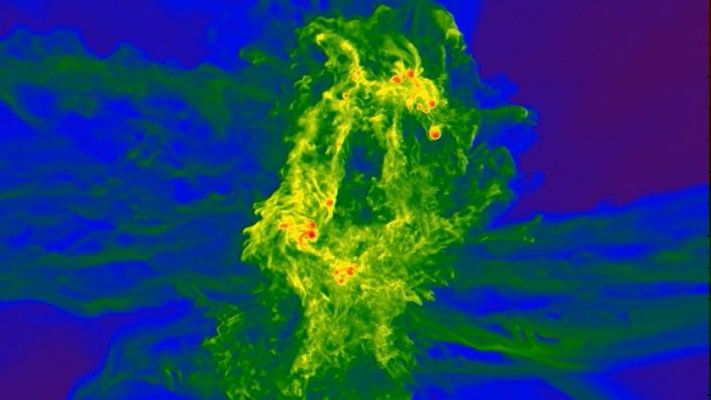Science
Related: About this forumThe oldest, brightest black holes in the universe were born from violent gas attacks, new study sugg
The oldest, brightest black holes in the universe were born from violent gas attacks, new study suggests
By Brandon Specktor published about 20 hours ago
Some supermassive quasars formed within the first billion years after the Big Bang. Now, scientists know why.

A supercomputer simulation shows massive stars forming (red) in a cloud of ancient gas. (Image credit: University of Portsmouth / Nature)
Twinkling like cosmic lighthouses on a shore 13 billion light-years from Earth, quasars are some of the oldest, brightest relics of the early universe that astronomers can detect today.
Short for "quasi-stellar radio sources," quasars are gargantuan black holes that glow as brightly as galaxies and are millions to billions of times as massive as Earth's sun. Today, quasars exist at the centers of many large galaxies. But thanks to their exceptional luminosity, quasars have been tracked far across space-time, with roughly 200 of them identified as forming within the first billion years of our universe's history.
How could such massive objects form so early, when galaxies were sparse and large stars were exceptionally rare? The question has bedeviled researchers for more than two decades, since the first quasars were identified — and now, a new study published July 6 in the journal Nature(opens in new tab), may provide a long-sought answer.
Using a computer simulation, researchers modeled star formation in the early universe, focusing on one of the rare junctures where two streams of cold, turbulent gas met. While streams of star-forming gas crisscross the universe like cosmic interstates today, the natural "clouds" or reservoirs where two streams met were exceedingly rare within the first billion years after the Big Bang, making them tempting but elusive areas of study.
More:
https://www.livescience.com/oldest-quasars-in-universe-formation
SeattleVet
(5,589 posts)it must have been the eggs, chili, and greasy lamb.
rownesheck
(2,343 posts)I read the headline and thought, "sounds like the same problem I have with my underwear."
Glad to know I'm not the only one with a 12 year old's sense of humor!
The Unmitigated Gall
(4,522 posts)That when they collapse to something like a star, it barely has time to put out any light before it all just goes down to a black hole. No supernova required.
Then it keeps on eating.
eppur_se_muova
(37,397 posts)Wicked Blue
(6,650 posts)That image looks strangely like me when I'm having a reflux attack.